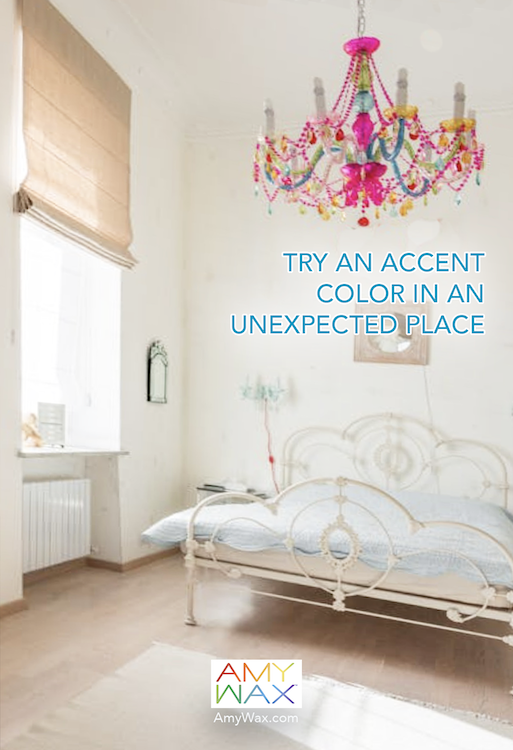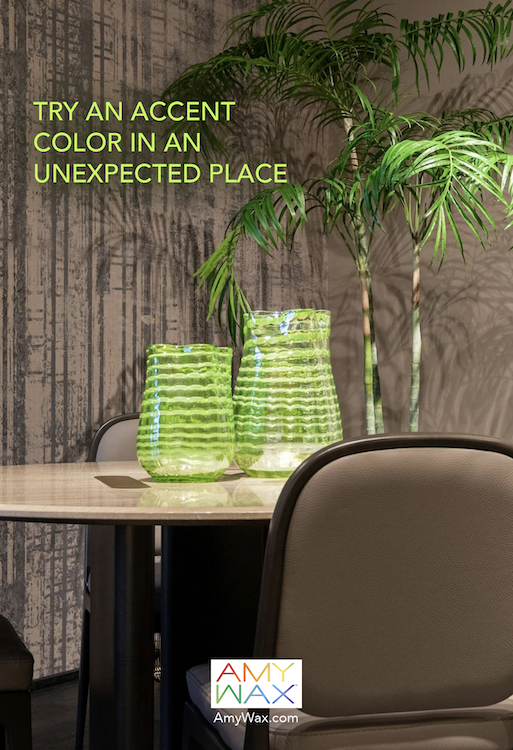
Accent colors are not a new subject for my blog, and if you’re a frequent reader, you’ll know I’m always looking for opportunities to layer in pops of color whenever possible. I’ve written about using accent colors for walls, decorative pieces, and many other areas throughout the home. Still, even I have found accent colors in unexpected places that took me for a pleasant surprise, and I’d like to share some of those surprises with you!
Occasionally, we find a color that takes our breath away and keeps our attention. Almost like a schoolyard crush, this color sticks in our minds, and we can’t stop thinking about it and how we can use it in our homes. But this can be difficult, and working a color into a scheme without intention or understanding can yield unintended results.
When a client of mine or I get this feeling of a “color obsession,” as I like to say, with a specific hue that may not have been conceptualized when an original palette was created, it’s possible to find a use for this color as an accent color in places that offer a fresh new approach!
Most people think of accent colors placed in non-functional places or on non-functional/non-utility items, but accent colors are not limited to desktop accessories or wall art; they can also serve their purpose on day-to-day functional items and furniture.
Sometimes, adding accent colors in those unexpected places is the most rewarding!

Accent colors can completely transform quiet, neutral spaces like dining rooms, bathrooms, or kitchens by injecting energy/personality, and when done tactfully, these accents won’t overwhelm the room. These are the circumstances where you can work in your color crush without it being a distraction or throwing off the room’s balance.
Many homes today are comprised mostly of soft tones—like whites, grays, or beiges. Neutrality or cool colors have been popular and are now the standard in interior design. But, when we add a pop of color, it becomes a focal point, instantly drawing in the eye and adding character and layers to the space.
Whether it’s a bold/loud chandelier over a stark white master bed, a vibrant faucet in a minimalist kitchen, or a brightly patterned tile in a serene bathroom, small bursts of color break up the neutrality, turning understated spaces into ones that feel curated and alive!

Here are some unexpected places I suggest using an accent color that you just can’t live without:
Pendant lights provide functional overhead lighting and create a dynamic design statement. Bars and kitchen islands are usually near-neutral marble or slate, but you can elevate the kitchen with a pop of bold ruby red! What was once out of site and purely functional is now a visually dynamic accent piece!
Sure, a seafoam green or bold turquoise may not be the best option for your dining room walls (unless you’re color drenching!), but it can be a great choice for your kitchen seating or even a small coffee/end table. A color like turquoise plays beautifully off light, crisp wood finishes, like bamboo or white oak, without dark staining. This pairing is energetic and playful but not overbearing.

Not often, but sometimes I’ll work with a client on outfitting their fireplace mantle, whether wood or stone, with a vibrant accent color. It’s a bold choice, but when executed well, it’s a riveting and memorable look. We’re all used to seeing beautiful brickwork or even white-painted wooden mantles, so using a blue, burgundy, or forest green to play against the more neutral colors of the room makes the fireplace stand out even more.
If you don’t want to paint brick but have a woodstove in front of the hearth, it can be treated with heat-resistant paints to provide a color pop. I recently chose colors for a large open loft-like home with a hearth at one end of an oversized space. By the time I was done, the stove pipe coming out of the iron black stove would be painted a metallic gold. Yes, it’s a bold choice, but I assure you it will be stunning once it’s done!

People tend to think some items and spaces within their homes are off-limits to accent colors, and I want you to throw that philosophy out the window! Using accent colors is not just an achievement that countertop accessories or throw pillows can accomplish; accent colors can have more permanent installations on functional items in high-traffic areas. An accent color is best used where you need it most – spaces lacking visual interest and design layering.
So, how do you feel about using accent colors in unexpected areas? They can make your home memorable and fun. Whether you are adding decorative or statement pieces or colorful furniture, consider the colors you have fallen in love with at one time or another and include them in your home.
Please share your thoughts with me; as your color specialist/color expert, I always love hearing how people feel about using color in unique ways!
